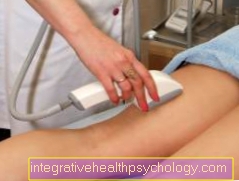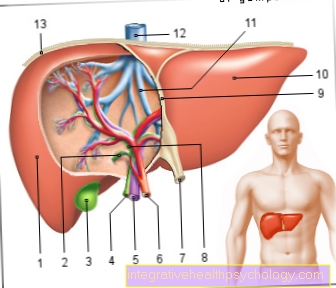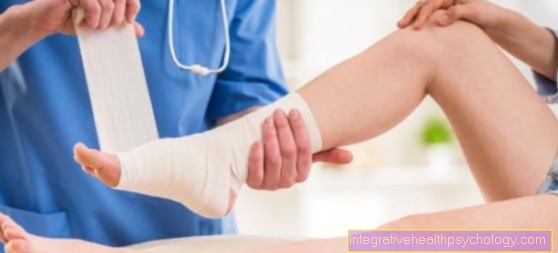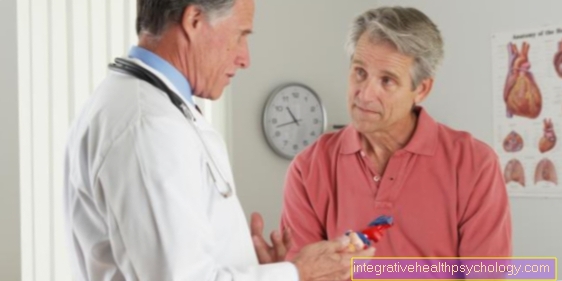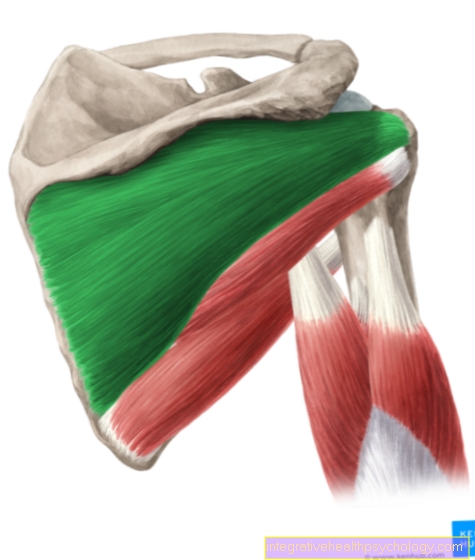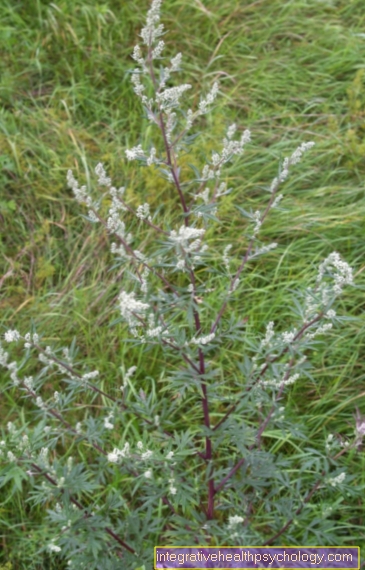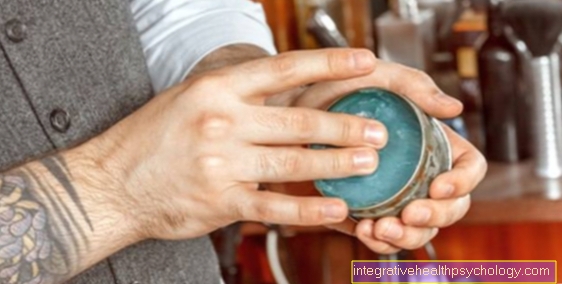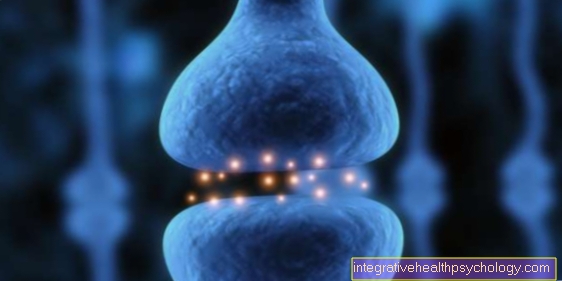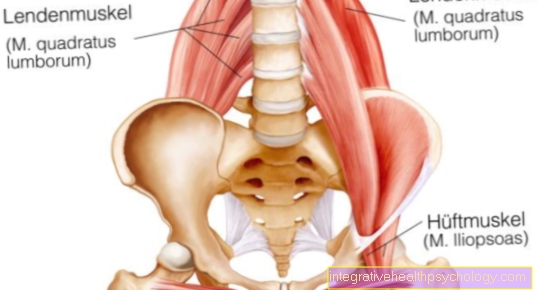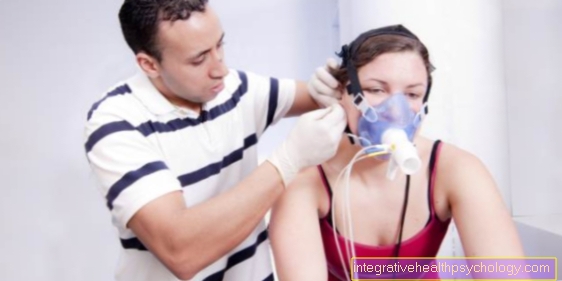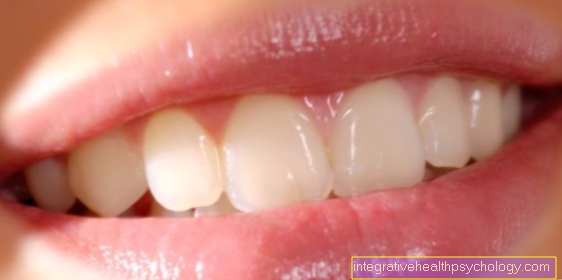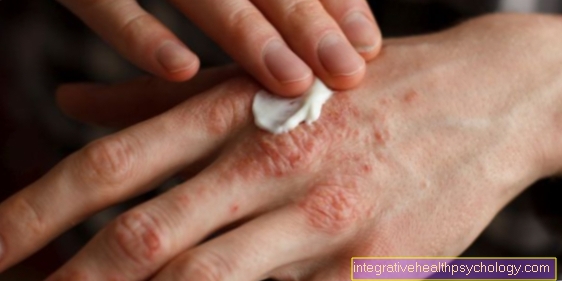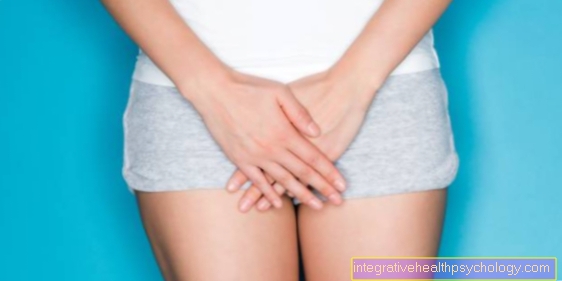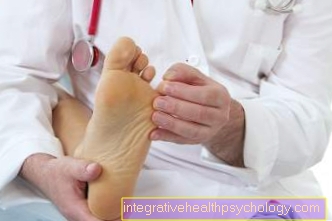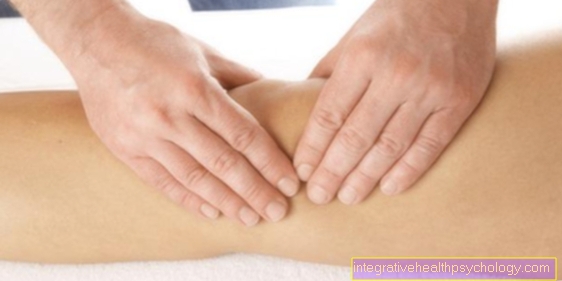Patellar tendon
introduction
The patellar tendon is a stiff ligament that leads from the kneecap (patella) to a rough protrusion (tibial tuberosity) on the front of the shinbone (tibia). The tape is about six millimeters thick and five inches long. The patellar tendon is an extension of the insertion tendon of the four-headed thigh muscle (quadriceps femoris muscle) and is therefore essential for the extension of the knee joint. In addition, the patellar tendon with its fibers secures the joint capsule of the knee joint. The muscle pull of the quadriceps muscle is deflected by the kneecap, which leads to easier stretchability and power transmission in the knee joint.
The patellar tendon is exposed to heavy loads, especially in athletes. If you have started or resumed heavy exercise, pain, inflammation or, in the case of pre-existing damage, even tearing of the patellar tendon can occur. In adolescents and athletes, the so-called patellar tip syndrome often occurs, in which the anchoring of the ligament on the kneecap is painful.
Figure knee joint

A - Right knee joint from the left
B - Right knee joint from the front
C - Right knee joint from behind
- Kneecap - patella
- Femur - Femur
- Shin - Tibia
- Fibula - Fibula
- Inner meniscus -
Medial meniscus - Outer meniscus -
Lateral meniscus - Kneecap ligament -
Patellar ligament - Outer band -
Ligament collaterale fibulare - Inner band -
Ligament collateral tibial - Posterior cruciate ligament -
Ligament cruciatum posterius - Anterior cruciate ligament -
Ligament cruciatum anterius
You can find an overview of all Dr-Gumpert images at: medical illustrations
Cause of illness
When the knee is extended, extreme forces act on the patellar tendon. These are exacerbated by sudden braking when stopping from a sprint or by the braking forces when landing from a jump. The patellar tendon is also heavily stressed when lifting heavy weights. These stresses can lead to various illnesses or injuries.
Pain / symptoms
There is pain in the patellar tendon area often. Not only professional and competitive athletes, but also recreational athletes can develop pain in this area. Typical are pain after especially high loads the patellar tendon. These are especially sports Jumps and Sprints, such as hurdles. Also strong Slowing down with the knee bent can strain the tendon. The pain is particularly strong when bending and stretching the knee against resistance, such as when Climb stairs, Going downhill or heavy lifting. At rest, the pain can often be triggered by pressure on the patellar tendon. Usually, a break in exercise is sufficient to get rid of the pain. Then the leg muscles should be slowly strengthened again (see below).
Inflammation of the patellar tendon
With high loads it can Inflammation of the patellar tendon come. It refers to aseptic Inflammation, that is, inflammation without one bacterial or viral Pathogen. The inflammation is caused by Micro injuries and heavy load. The result is pain when the knee is loaded. A overheat or swelling in the area of the patellar tendon also suggest an inflammatory process. A special form of such inflammation is the aforementioned patellar tip syndrome.
There is also rarely an aseptic Bone necrosis of the patellar tendon attachment to the tibial tuberosity (am Shin), the so-called M. Osgood-Schlatterthat affects young athletic adolescents and has a good prognosis with conservative therapy.
Patellar tip syndrome

The patellar tip syndrome describes pain at the base of the patellar tendon on the lower edge of the kneecap (patella), which is caused by a non-bacterial inflammation (similar to a tennis or golfer's arm). The pain usually occurs when moving. Going downhill and climbing stairs in particular trigger the pain, and prolonged sitting and the resulting knee flexion can also be painful. Often the pain can also be triggered by pressure on the patellar tendon. They are the result of muscular overload. Patellar tendon syndrome is the most common tendon disease among adolescents. The patellar tip syndrome is sometimes also called "jumper's knee", as particularly high forces act on the patellar tendon when jumping and landing. Basketball players, volleyball players, handball players and high jumpers are often affected. In addition, sprinters and athletes are at risk in sports with frequent accelerations and decelerations (such as squash).
Small injuries and tiny tears within the patellar tendon are believed to cause an inflammatory response, which in some cases can also lead to redness and swelling. People with congenital ligament weakness (laxity), with an elevated patella (patella alta) and with developmental and growth disorders of the kneecap are particularly at risk.
Due to a lack of sports breaks, the clinical picture can persist for months or years or recur frequently.
Read more on the topic: Patellar tip syndrome
diagnosis
A detailed one History taking (Consultation with the patient) with special attention to the types of sport practiced and occupational stresses can play an important role in the diagnosis of a patellar tendon disease. When examining the knee, a Tenderness at the lower edge of the kneecap (patella). Pain in the Extension of the knee against resistance corroborate the suspicion. To confirm the diagnosis of patellar tip syndrome or the like, a Ultrasonic or a MRI (Magnetic resonance tomography).
therapy
In diseases of the patellar tendon should first burden of the knee joint avoided become. Therefore, the sport that causes the symptoms should be paused for a sufficiently long time. It helps to keep the knee joint as still as possible. For severe pain, pain relievers such as Diclofenac and Ibuprofen be taken. Local application of pain reliever and anti-inflammatory ointments such as diclofenac / Voltaren can help. Often helps with acute pain after exercise CoolIn the further course, building up the muscles with the help of physiotherapy can be helpful. Injections of Glucocorticoids (Cortisol) and Local anesthetics must be carefully considered because of the increased risk of tearing the patellar tendon. In addition, there is always a risk of infection with invasive measures.
Stabilization by means of an elastic band or by taping can help to reduce the strain on the knee during exercise.
In the case of long-lasting complaints and severe damage, an operation can also be useful.
forecast
The prognosis of diseases of the patellar tendon is favorable with consistent and early treatment. If symptoms recur very often and if treatment is inadequate, it may be necessary to switch to a sport that puts less strain on the patellar tendon (e.g. swimming, cycling).
prophylaxis
To avoid putting undue strain on the patellar tendon, there are a few principles that should be followed. In running sports, it is important to use suitable footwear with the greatest possible cushioning. If the problem is known, a soft floor should be preferred to hard concrete. When starting a new sport, the intensity should be slow and adapted to the progress. This also and especially applies when starting again after a (for example injury-related) training break, since the stress is often underestimated, especially then. Peak loads should be minimized, especially in sports with jumps. Sufficient warm-up should take place before training, and the leg muscles should be strengthened and stretched after training.
Extreme case of patellar tendon rupture
A rupture of the patellar tendon usually only occurs in older ageif the tendon is already through wear is damaged. Triggers are typically heavy loads in the bent knee, such as jumping from an elevation when carrying heavy loads (for example when unloading a truck). Sometimes the tendon tear can even be heard.
Typical symptoms of a patellar tendon tear include an inability to hit the knee to stretch against resistance (stretching without straining the knee is usually still possible), if necessary the kneecap and your kneecap stand up hike when the four-headed thigh muscle (M. quadriceps femoris) is tensed. If in doubt, an ultrasound or an MRI can help to confirm the diagnosis.
Surgical anchoring of the patellar tendon is usually used as a therapy.
You can find more information at: Rupture of the patellar tendon


